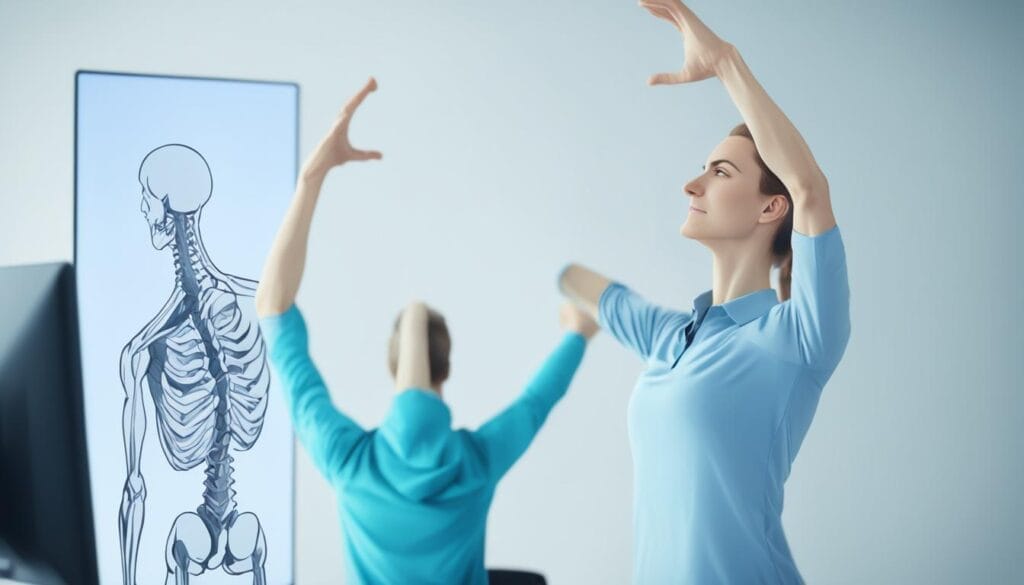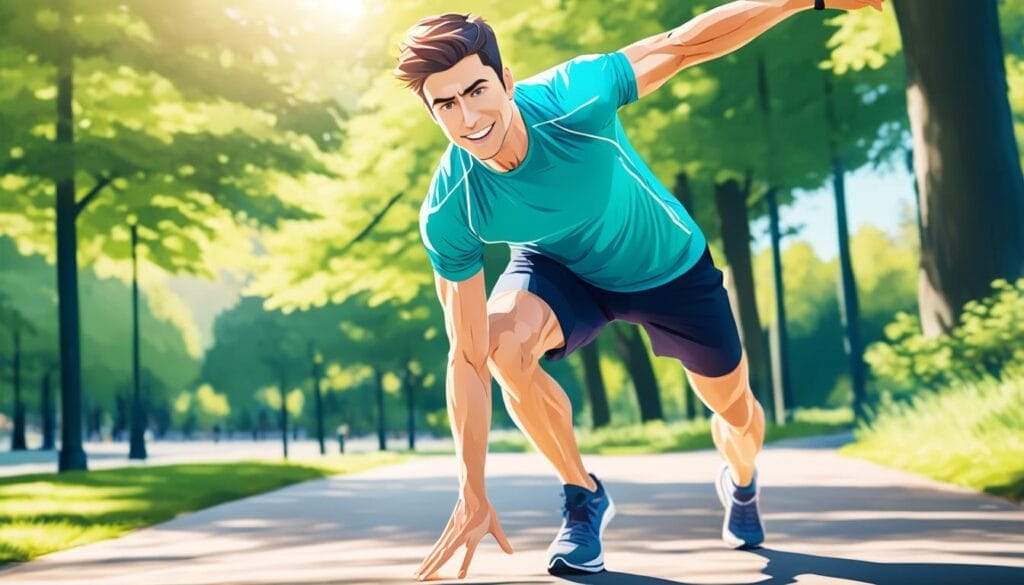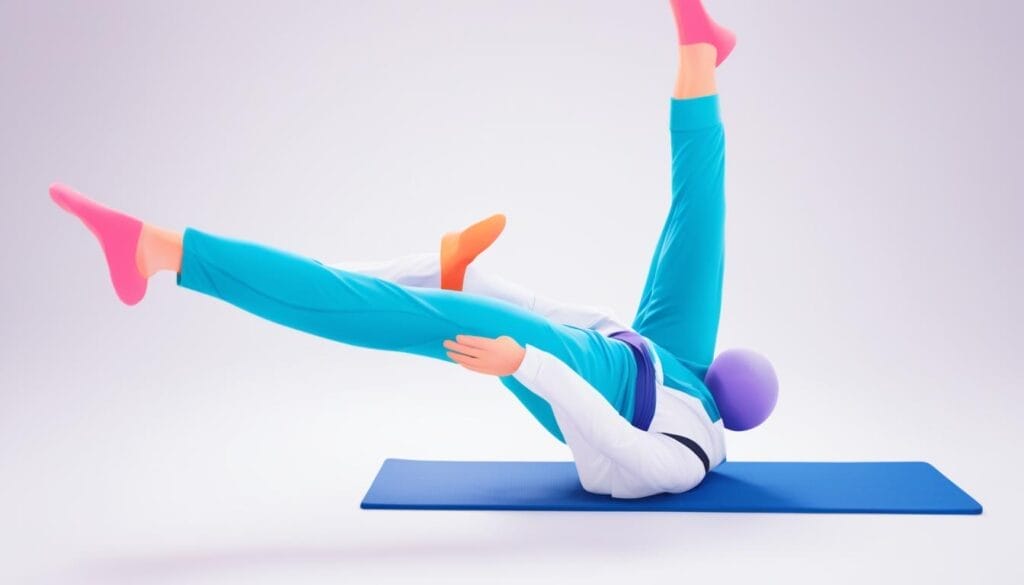Have you ever felt trapped in your own body? A few years back, that’s exactly how I felt. Every day started with a stiff back, tight shoulders, and muscles that ached. It was like the world’s weight was on my shoulders. My lack of being flexible and bad posture caused this.
To feel better, I decided to change things. It was a tough journey, but I gained so much. I move freely now, and my health has improved a lot. Now, I’m taller, walk with ease, and feel good about myself.
If my story sounds like yours, I want to tell you there is hope. In this article, I’ll share what worked for me. We’ll look at how improving flexibility and posture changes everything, letting you take charge of your health and life.
Key Takeaways
- Improving flexibility and posture is crucial for overall health and wellbeing.
- Paying attention to your body and identifying areas of tightness is the first step towards enhancing flexibility.
- Good posture plays a significant role in improving flexibility and reducing muscle tension.
- Both stretching and strengthening exercises are essential for achieving symmetrical flexibility and strength.
- Simple everyday habits, like sitting on the floor and taking stretching breaks, can make a significant difference in improving flexibility.
The Importance of Paying Attention to Your Body
Many people don’t notice how stiff or inflexible they are. It’s key to check which parts of your body can move freely and which can’t. Places like your neck, shoulders, and hamstrings are often very tight. If you focus on these areas, you take the first step to being more flexible and having better posture.
Being aware of your body means knowing how it moves and spotting areas that might need work. Often, you don’t realise you’re not flexible until it’s a problem. You might feel uncomfortable or find daily tasks hard. By being more body aware, you can find tight or stiff spots. Then, you can start to loosen them up.
“Being aware of how your body feels and moves is the key to unlocking its potential. Without body awareness, you may continue with activities that exacerbate your lack of flexibility, further hindering your progress,” says Dr. Sarah Johnson, a renowned physiotherapist.
One great way to tune into your body is through mindfulness practices like yoga or tai chi. These help you connect your mind and body. This connection allows you to feel and understand every part of your body. Through these exercises, you learn to hear what your body needs and can make smart choices about your training.
Spotlight on the Lack of Flexibility
- Neck: Not being able to move your neck well can cause pain and limit how far you can turn your head. Doing neck stretches and exercises can ease the tightness.
- Shoulders: If your shoulders are stiff, it could be from sitting a lot or not standing straight. Stretching and strength exercises can make your shoulders move better and feel less tense.
- Hamstrings: Often, people find their hamstrings very tight, leading to back pain and less movement. Doing gentle stretches, like touching your toes or sitting and reaching for your feet, can help.
Each person’s body is unique, and you may have different tight parts. It’s good to check your own body and see what you need to work on. This lets you focus your flexibility plan on what your body requires.
Looking after your body’s flexibility opens up more movement, improves how you stand and lowering injury chances. Remember, everyone’s flexibility journey is personal, and it takes time. Stay patient, hear what your body tells you, and celebrate each step of progress.
The Role of Good Posture in Improving Flexibility
Good posture helps a lot in making you more flexible. Sitting with your head forward and shoulders bent can make your muscles tight. But, if you sit or stand straight, lining up your ears, shoulders, and hips, you will get more flexible. Doing exercises to fix your posture daily can really change how flexible and straight you are.
Having bad posture messes up how your body is lined up. This can cause trouble when you try to move your body in different ways. So, fixing your hunched back first makes it easier to get more flexible.
Getting your head and shoulders in line with your back is a big part of fixing your posture. This makes it easier for your neck, shoulders, and upper back to move without being stiff. It also stops your muscles and joints from hurting because you’re standing or sitting wrong.
Good posture is more than just not slouching. It’s something you must think about all day. Practising standing and sitting the right way and doing stretches will help your body learn to do it by itself.
There are many ways to get better posture and more flexibility. Stretching helps loosen tight muscles in your chest, shoulders, and hips. This will make your posture and body alignment better. Exercises to make your core, back, and shoulders stronger also improve your posture and how flexible you are.
Getting better at having good posture and being flexible takes time and being steady. Try to keep your back straight and your body in good shape all day. If you stick with it, your posture and how flexible you are will get a lot better.
Adding good posture to your daily life is great for more than just being flexible. It helps you avoid getting hurt, relaxes your tight muscles, and makes you move better. Keeping your body in good order means you can do more without pain.

The Power of Stretching and Strengthening
Flexibility improves with both stretching and strengthening. A balance between these two is key. By including these in your workout, you boost mobility and strength.
Favourite Workouts for Strength and Flexibility
Many exercises mix strength and flexibility. Here are some I enjoy:
- Barre: It combines ballet, Pilates, and yoga. Each movement targets a muscle group, making you strong and flexible. You’ll do isometric exercises and dynamic stretches.
- Pilates: It strengthens your core and increases your flexibility. Its controlled moves and special breaths involve deep muscles.
- Yoga: It improves flexibility and strength through poses. Changing poses works different muscles, making you more flexible and stronger.
- Dance: A fun way to get stronger and more flexible. It involves rhythmic moves and stretches, improving muscle tone and movement range.
Adding these workouts to your routine boosts strength and flexibility. Consistency helps you get better over time.
Flexibility Training: Finding the Right Balance
It’s important to do both types of exercises for the best flexibility and strength. Flexibility is needed but without strength, you might be shaky. Too much strength but not enough flexibility can limit your movement.
Remember to have a mix in your flexibility program:
- Static stretches: Hold each stretch for about 30 seconds to improve muscle flexibility.
- Dynamic stretches: Perform movements that mimic the activities you’ll be engaging in.
- Resistance training: Use weights or bands to make muscles strong and stable.
- Core exercises: Target your abs, back, and pelvis for better balance and stability.
By mixing stretch and strength exercises well, you will see great flexibility results. This makes your fitness well-rounded.
“Strength and flexibility work hand in hand, allowing you to move with ease and grace in your everyday life.”
| Workout | Focus | Benefits |
|---|---|---|
| Barre | Targeted muscle groups, ballet-inspired movements | Increased strength, flexibility, improved posture |
| Pilates | Core strength, controlled movements | Improved flexibility, enhanced core stability, better body alignment |
| Yoga | Breathing techniques, flowing poses | Increased flexibility, improved balance, reduced stress |
| Dance | Rhythmic movements, full-body engagement | Enhanced strength, flexibility, coordination, cardiovascular endurance |
Everyday Habits to Improve Flexibility
You can boost your flexibility outside of workout time. Try simple habits in your day to day life. They’ll make you more flexible and agile.
Sitting on the Floor
Sitting on the floor can greatly improve flexibility. It’s not just for kids or yoga fans. Positions like cross-legged or kneeling stretch your hips, back, and more. This can reduce stiffness and make you more flexible over time. And it’s a nice change from sitting in chairs all day.

Flexibility during Daily Activities
Add stretches to your daily routine. When you’re waiting, do a few gentle stretches. Or at your desk, try some wrist stretches. These little moments of stretching can really help with your flexibility. This can make your body more supple without a lot of effort.
Stretching Breaks
Take short stretching breaks to feel better. They’re great for your mind and body. Whether at work or on a break, do some easy stretches. It could be a bend or a twist. This boosts your energy and keeps you flexible.
Make flexibility part of your day. Look for chances to move and stretch. This way, you improve little by little, without needing extra time.
Summing Up
Being flexible and having good posture is essential for a better life. You can boost your flexibility and posture by using the tips in this article. This includes being aware of your body, sitting and standing straight, and doing exercises to stretch and strengthen. Also, small lifestyle changes go a long way.
It’s important to stick with these tips to see real changes. Making these exercises a part of your routine regularly will help a lot. So, start now and enjoy moving more easily and standing taller by following these steps every day.
Any step you take, however small, is progress. You can simply sit on the floor more or stretch when you take a break. Adding a bit of exercise to your daily tasks is easy and can make a big impact. This simple effort will lead to a lasting improvement in how you move and look.
FAQ
Why is improving flexibility and posture important?
Improving flexibility and posture is key for our health and mood. It prevents injuries, betters our posture, and eases muscle tension.
What areas of the body tend to be tight or lacking flexibility?
The neck, shoulders, and hamstrings are often tight and need more flexibility.
How does good posture contribute to improved flexibility?
Good posture helps our muscles stay flexible. It keeps our body in a natural balance that prevents stiffness.
What are some exercises that can improve both flexibility and strength?
Exercises such as Barre, Pilates, yoga, and dance work wonders. They boost your flexibility and strengthen you evenly.
What are some everyday habits that can improve flexibility?
Sitting on the floor in different ways stretches the hips, back, and legs. A stretching break during the day and adding flexibility exercises to chores or walks can also help.
How can I incorporate flexibility improvement techniques into my daily routine?
Make stretching a daily habit for better flexibility. Pay attention to how you stand and move, and do regular exercises for flexibility and strength.
Source Links
Share Me:
READY TO UNLEASH
YOUR BEST SELF?
Click “Sign Me Up!” And Start Your Fitness Transformation!





